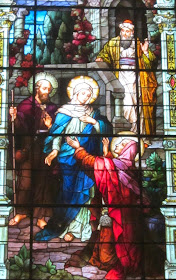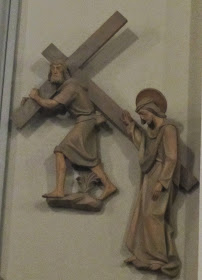The church is a Roman basilica design, with interior columns that divide the space and a wide central aisle. The exterior portico with its massive Doric columns was added in the 1870s, and the 103-foot-tall gold-topped towers were completed in 1884.
At one time the Archdiocese of Mobile included all of present-day Alabama and Florida, but today it includes just the Catholic parishes in the twenty-eight southern counties of Alabama. However, it was still important enough to the region that Pope John XXIII designated this building a minor basilica in 1962, and hence the "Cathedral-Basilica" designation.
The beautiful iron gates reveal the French influence of the region:
An inscription on this stone carving of a bishop's mitre at the side of the main entrance reads: "Pray for the soul of John, Second Bishop of Mobile."
A coat of arms inlaid on the marble floor:
The red and white nave is very beautiful. The soaring sixty-foot-tall barrel vaulted ceiling and ample windows make the room airy and light.
A beautiful marble and gold altar in the sanctuary is topped by a bronze resurrected Christ:A gilt altar honoring Mary and the Immaculate Conception is on one wall:
This crucifixion scene, with the red background and the grieving women, is very moving:
Close ups:
Stained glass windows, installed between 1890 and 1910, were made in Munich, Germany. Rather than focusing on the life of Christ, the beautiful panels depict Mary's story, beginning with her presentation at the temple as a child:
The Angel Gabriel and the Annunciation:
Mary and Elizabeth, both having had miraculous conceptions, meet:
Mary gives birth to the Christ child:

The boy Jesus plays at Mary's feet while she spins yarn, his father Joseph looks on, and a benevolent God keeps watch over all:
The wedding feast, where Jesus performs his first miracle of turning water to wine while Mary looks on:
Mary and others and the foot of the cross:
Close-up view. Which one do you think is Mary? She is wearing blue in all of the windows, and she is singled out here by her golden crown:
The Assumption of Mary into Heaven:
Mary is crowned Queen of Heaven by her Son:
Angels with lovely green wings (a first for me) hold up the cloud Mary and Jesus are on:Mary on her heavenly throne:
In 1954 the interior of the cathedral was nearly destroyed by fire, and the windows were heavily damaged by smoke and water. They were dismantled and sent back to Germany for restoration. Now, sixty years later, the windows are ready for additional restoration and conservation, and a U.S. firm has been contracted to do the work. Fundraising is underway as each window is valued at $144,000, and the cost of restoration is $59,000 per window. Protective glass will also be installed over the windows.
In between the windows are the Stations of the Cross, a tradition I do not have in my own religion, but which I have come to appreciate. Fourteen figures represent the Passion of the Christ and are to be viewed in order as one walks around the perimeter of the church while meditating on these final moments of Christ's life.
It begins with Christ being condemned to death, and then carrying his cross.
He falls for the first time, and then meets his mother:
Simon the Cyrene helps to carry the cross, and Veronica wipes Jesus' face:
Jesus falls the second time, and then meets the women of Jerusalem:
He falls the third time, and then is stripped of his clothing:
The crucifixion and subsequent death of Christ:
Jesus' body is removed from the cross and placed in the tomb.
The tradition of moving around the Stations began with St. Francis of Assisi. Today, it is most commonly done formally during Lent.
The last part of the cathedral we viewed was the Crypt Chapel, created in 1962 for deceased bishops. The entrance is a circular stairway placed among the pews:
A bronze bust of a passionate Christ watches visitors descend the stairs:
Not too far away is a more peaceful depiction of Christ holding live flowers:
Wrought iron gates prevent access to the crypt:
But my camera gave me a good view of the colorful, modern painting of the crucifixion:
. . . and the individual crypts in the wall:
For a city of under 200,000 people, Mobile's Cathedral-Basilica of the Immaculate Conception is a remarkable structure with a long history. It's well worth a visit.


























.JPG)





















never would think of Alabama as a catholic place.
ReplyDeleteI love the focus on Mary.
ReplyDeleteI'm so totally getting a stone to put by my front door, seeking prayers for those who come to visit me. It's a great idea! Beautiful church; thanks for the tour.
ReplyDeleteYou got all kinds of stuff out of that church that I missed. I must have been next door at a different one. All of the stained glass and stations of the cross. Great post.
ReplyDeleteThis comment has been removed by the author.
ReplyDeleteWhat an AWESOME recount of history! Everyone in Mobile should know their history!
ReplyDelete